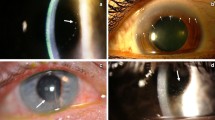Summary
The theme deals with the experimental joining with adhesives of 4 to 6 mm long perforated keratotomies in nine rabbit eyes with the rapidly polymerizing adhesive butyl-2-cyano-acrylate.
Application of the adhesive onto the wound area, which was freed from epithelium, is possible without complication directly from the tube. Unnecessary adhesive which has come on the uninjured cornea will be removed by means of a resharpened iris spaluta.
Good compatibility of the adhesive was observed. After three weeks clinically a thin cornea scar shows. Slight scar tissues, but no vascularisations and no chronical symptoms of inflammation were to be seen in the histological final examinations after five months.
Zusammenfassung
Das Thema behandelt die experimentelle Klebung von 4–6 mm langen perforierten Hornhautschnitten an 9 Kaninchenaugen mit dem schnell polymerisierenden Butyl-2-Cyanoacrylat-Klebstoff.
Ein komplikationsloses Auftragen des Klebers auf den von Epithel befreiten Wundbereich ist direkt aus der Tube möglich. Überflüssiger auf die unversehrte Hornhaut geratener Kleber wird mit einem angeschliffenen Irisspatel abgehoben.
Eine gute Verträglichkeit des Klebers wurde beobachtet. Nach 3 Wochen zeigt sich klinisch eine schmale Hornhautnarbe. In den histologischen Abschlußuntersuchungen waren nach 5 Monaten leichte Narbengewebe, aber keine Vascularisationen und keine chronischen Entzündungszeichen zu erkennen.
Similar content being viewed by others
Literatur
Bloomfield, S., Barnert, A. H., Kanter, Ph. D.: The use of Eastman—910 monomer as an adhesive in ocular surgery. I. Biologic effects on ocular tissue. Amer. J. Ophthal., Ser. 3, 55, 742–748 (1963).
— — —: The use of Eastman—910 monomer as an adhesive in ocular surgery. II. Effectiveness in closure of limbal wounds in rabbits. Amer. J. Ophthal., Ser. 3, 55, 946–953 (1963).
Carton, S. A., Kessler, L. A., Seidenberg, B., Hurwitt, E. S.: Zit. bei Lieb.
Contzen, H.: Begründete Anwendungsmöglichkeiten für klebende Autopolymerisate. Sitzungsber. Dtsch. Ges. für Chirurgie, 83. Tagung vom 13.–16. 4. 1966 in München. Zbl. Chir. 91, 1031 (1966).
Ellis, A. E., Levine, A. M.: Experimental suturless ocular surgery. Amer. J. Ophthal., Ser. 3, 55, 733–741 (1963).
Faul, P., Heiss, W., Struppler, A., Brendel, W.: Ersatz der chirurgischen Nervennaht durch Klebstoff. Zbl. Neurochir. 26, 3–12 (1965).
Gibel, W., Wildner, G., Marx, G., Matthes, Th.: Vergleichende Untersuchungen über die Verwendung von Cyanoacrylat-Gewebeklebern in der Thoraxchirurgie. Zbl. Chir. 93, 550–556 (1968).
Giebel, M. G.: Experimentelle Ergebnisse bei Klebungen statt Naht an verschiedenen Geweben. Sitzungsber. Dtsch. Ges. für Chirurgie, 82. Tagung vom 21.–24. 4. 1965 in München. Zbl. Chir. 90, 1691–1692 (1965).
Gießmann, H.-G., Schlote, H.-W., Tuchscherer, V., Zeller, R.: Die Anwendung von Gewebekleber am Auge im Kaninchenversuch. II. Lamellierende Keratoplastik. Albrecht v. Graefes Arch. klin. exp. Ophthal. 183, 301–309 (1972).
Kutschera, E.: Gewebekleber in der Chirurgie des vorderen Augenabschnittes. Klin. Mbl. Augenheilk. 156, 248 (1970).
Lieb, W., Müller, E.: Eastman — 910 Monomer als Ersatz augenchirurgischen Nahtmaterials. Arquiros Portugueses de Oftalmologia Fasciculo Unico Volume 19°. Lisboa 1967.
Lepri, G., Tota, G.: L'Eastmann—910 quale sostanza adesiva nelle ferite corneali sperimentali. Boll. Oculist. 44, 343–354 (1965). Ref. Zbl. ges. Ophthal. 96, 474 (1966).
Levine, M.: Suturless ocular surgery: results of recent experiments. Eye, Ear, Nose Thr. Monthly 43, Nr. 9, 55–58 (1964). Ref. Zbl. ges. Ophthal. 93, 177 (1965).
Loew, G., Herrmann, H. D., Palleske, H.: Experimentelle und klinische Erfahrungen mit lyophilisierter Dura und Histocoll T 100 B in der Neurochirurgie. Melsunger med. Mitt. 41, 49–60 (1967).
Refojo, M. F., Dohlmann, C. H., Ahmad, B., Carrol, J. M., Allen, J. C.: Evaluation of adhesives for corneal surgery. Arch. Ophthal. 80, 645–656 (1968).
Reim, M., Vogt, M.: Das Kleben von Hornhautwunden im Kaninchenversuch. Albrecht v. Graefes Arch. klin. exp. Ophthal. 179, 53–64 (1969).
Richter, S.: Tierexperimentelle Untersuchungen über die Anwendung von Gewebeklebern bei Augenoperationen. Vortrag: Tagung der Berliner Augenärztlichen Gesellschaft am 4. und 5. 12. 1969, Humboldt-Universität (Charité), Berlin.
Author information
Authors and Affiliations
Rights and permissions
About this article
Cite this article
Giessmann, H.G., Schlote, H.W., Tuchscherer, V. et al. Die Anwendung von Gewebeklebern am Kaninchenauge. Albrecht von Graefes Arch. Klin. Ophthalmol. 183, 294–300 (1972). https://doi.org/10.1007/BF00496156
Received:
Issue Date:
DOI: https://doi.org/10.1007/BF00496156




